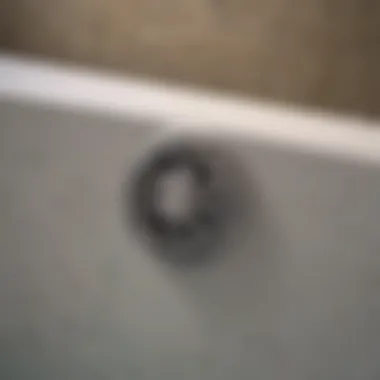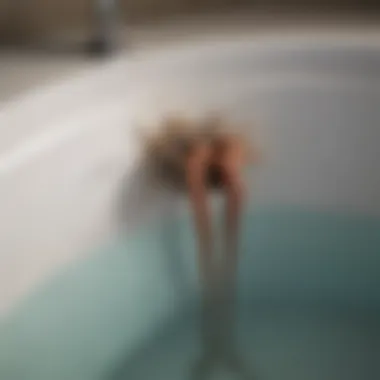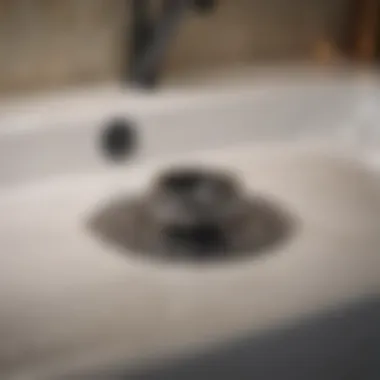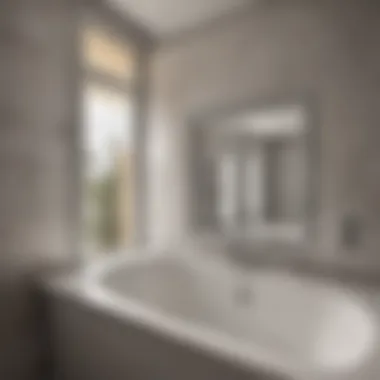Understanding and Addressing Bathroom Tub Drain Odors


Intro
Bathroom tub drain odors are a common nuisance that can disrupt the comfort of your home. These unpleasant smells often result from a range of issues, including bacterial growth, clogs, and inadequate drainage systems. Understanding the underlying causes of these odors is essential for effectively addressing the problem.
In this article, we explore the common culprits behind bathroom tub drain odors. We also present practical solutions and maintenance tips that can help ensure your bathroom remains an inviting space. Prevention is key, and knowing when to seek professional assistance can save time and enhance your bathing experience.
Current Trends
A growing awareness of hygiene and the impact of household smells on well-being is influencing trends regarding bathroom maintenance. The importance of a clean, pleasant environment is leading homeowners to explore various maintenance strategies. Cleaning products that tackle bacteria effectively are becoming very popular.
Popular styles in bathroom design now emphasize functionality and cleanliness. Well-ventilated spaces with modern drainage systems are in demand. Homeowners are seeking durable materials that resist odor retention as well.
Causes of Odors
Bacterial Growth
Bacterial growth in drains is one of the foremost reasons for foul smells. This typically occurs when organic matter accumulates, creating an environment where bacteria can thrive. This includes hair, soap residue, and skin cells that wash down the drain.
- Regular cleaning can mitigate bacterial buildup.
- Use specialized cleaners that target bacterial growth.
Clogs
Clogs can trap water and organic material, leading to stagnation. This stagnation becomes an ideal breeding ground for odor-causing bacteria.
- Perform regular inspections to catch clogs early.
- Unclogging techniques include boiling water, baking soda and vinegar solutions, or specialized unclogging tools.
Improper Ventilation
Ventilation plays a crucial role in reducing odors. Poor airflow can lead to an accumulation of smells in the bathroom.
- Ensure your bathroom fan is functioning properly.
- Consider upgrading to a more powerful model if necessary.
Solutions to Address Odors
Addressing bathroom tub drain odors involves both immediate solutions and long-term maintenance practices.
Immediate Solutions
- Boiling Water: Pouring boiling water down the drain can help dislodge clogs.
- Baking Soda and Vinegar: This combination can break down organic matter and neutralize odors.
- Enzyme Cleaners: Products that contain enzymes can effectively digest organic matter and bacteria.
Long-Term Maintenance
- Regularly clean your drain with safe chemicals.
- Schedule routine plumbing inspections to ensure systems function correctly.
- Consider installing a drain strainer to catch debris before it enters the drain.
End
Understanding bathroom tub drain odors involves recognizing various contributors and appropriate solutions. Through regular maintenance, you can prevent the buildup of bacteria, clogs, and unpleasant smells. Paying attention to ventilation can further enhance the overall atmosphere in your bathroom.
Adopting these practices ensures a fresh and pleasant bathing environment, contributing to your family's comfort and hygiene.
Foreword to Bathroom Tub Drain Smells


Bathroom tub drain smells can be more than just an inconvenience; they can indicate underlying issues that require attention. Understanding why these odors occur is essential for every homeowner and housewife. An unpleasant smell not only affects the overall atmosphere of a bathroom but can also hint at potential health concerns. As we explore this topic, we will discuss how minor nuisances can escalate into significant problems if not addressed.
Unpleasant odors from a tub drain can be caused by various factors, like bacterial growth or blockages. These conditions may not always be visible, but they can lead to further complications, including damage to plumbing systems and increased maintenance costs. Therefore, recognizing the signs and sources is crucial for effective management.
Awareness is key. By identifying and addressing the causes of these odors proactively, homeowners can maintain a more pleasant living environment. Proper understanding equips individuals with knowledge to implement practical solutions and preventive measures.
"Proper maintenance and awareness can save time and money in the long run."
In this article, we will map out common causes, practical solutions, and preventive measures to keep bathroom tub drains odor-free. Each section will provide the necessary insights, helping you take charge of your bathroom’s hygiene and comfort.
Common Causes of Odors
Understanding the common causes of odors in bathroom tub drains is essential for effectively tackling unpleasant smells. Identifying the root cause can lead to timely interventions and prevent long-term issues. It can also save homeowners from incurring costly repairs or unpleasant surprises in their daily routine. Knowledge of the various factors that contribute to these odors enables a proactive approach to maintenance, ensuring healthier and more pleasant bathing experiences.
Bacterial Growth
Bacterial growth is often a significant player in creating foul smells from drains. When organic matter, such as hair, soap, or skin flakes, builds up in the pipes, it creates an ideal breeding ground for bacteria. These microorganisms thrive in wet environments, particularly when there's a lack of adequate cleaning. As these bacteria multiply, they emit gases and compounds that can cause offensive odors in your bathroom. It's important to recognize the presence of bacterial growth early to implement cleaning solutions and prevent further accumulation.
Sewage Backflow
Sewage backflow is another common cause that can severely impact drain odor. This situation occurs when wastewater reverses flow, causing the contents of the sewer system to enter the tub. It can result from clogged sewer lines or problems with the municipal sewage system. The resulting smell is often incredibly unpleasant and may indicate a serious underlying plumbing issue. Homeowners should seek immediate assistance if they suspect sewage backflow to avoid health risks associated with contaminated water.
Clogs and Debris Accumulation
Clogs and debris accumulation can lead to blockages in the drain, preventing water from flowing properly. Over time, this stagnation can create a breeding ground for odors. Common culprits for clogs include hair, soap residue, and even small items accidentally dropped in the tub. Regularly checking and cleaning the drains can mitigate these issues, ensuring a free flow of water and minimizing odors.
P-trap Issues
P-traps serve a critical function in plumbing systems by holding a small amount of water, creating a barrier that helps prevent sewer gases from entering the home. However, if the P-trap dries out due to infrequent use or malfunctions, the barrier is compromised. This situation can allow odors from the sewer line to travel up through the drain. Homeowners should consider running water through less-used drains regularly to maintain the water barrier and avoid P-trap issues.
By understanding these common causes of odors, homeowners can better navigate the solutions and preventive measures outlined later in the article. Recognizing and addressing these issues promptly not only enhances the bathing experience but also contributes to a healthier living environment.
Impact of Ventilation on Drain Odors
Ventilation plays a crucial role in maintaining a fresh and odor-free bathroom environment. When a bathroom lacks proper airflow, it becomes a breeding ground for unpleasant odors. This section highlights the significance of ventilation and how it directly impacts the odors coming from bathroom tub drains.
Importance of Airflow
Adequate airflow within a bathroom helps in the exchange of stale air with fresh air, reducing the concentration of odor-causing agents. When air can freely circulate, moisture levels decrease, preventing the growth of harmful bacteria and mold. Furthermore, proper ventilation assists in the evaporation of standing water, which often accumulates around drains, contributing to foul smells.
To ensure good airflow in your bathroom, consider these factors:
- Exhaust Fans: Install fans that can efficiently expel humid air.
- Open Windows: Use natural ventilation when weather permits.
- Air Vents: Ensure that air vents are not blocked by furniture or other items.
Signs of Poor Ventilation
Recognizing the signs of inadequate ventilation can help address issues before they escalate. Here are some common indicators that airflow may be insufficient:
- Mold Growth: Black or green spots on walls may indicate excess moisture.
- Stale Odors: Persistent bad smells, particularly near drains.
- Condensation: Excess moisture on windows and mirrors suggests poor air circulation.
"Proper ventilation not only eliminates odors but protect against long-term damage to your home's structure."


Addressing poor ventilation should be a priority. Consider regular checks on exhaust systems and ensure they are functioning optimally. With these advancements, your bathroom can remain fresh and inviting, significantly reducing the odors that emerge from tub drains.
Identifying the Source of Bad Smells
Identifying the source of bad smells in bathroom tub drains is crucial for effective odor management. It involves understanding specific elements that contribute to unpleasant scents. This section elaborates on the techniques for detecting the root cause of the odors. Addressing this issue promptly can prevent more significant plumbing problems in the future. It also aids in maintaining a fresher environment within the home.
Visual Inspection Techniques
Visual inspection is an initial step in identifying the source of odors emanating from your tub drain. Begin by examining the visible components of the drainage system.
- Check the Drain Cover: Remove the cover and inspect it for debris or buildup. Hair, soap scum, and other residues can accumulate and contribute to unpleasant smells.
- Look Inside the Drain: Using a flashlight, take a closer look at the inside of the drain. Any visible signs of grime or darkness can indicate organic matter that may be decomposing, thus emitting odors.
- Inspect the P-trap: The P-trap is the curved section of the plumbing beneath your bathtub. Ensure it is properly filled with water and check for leaks or blockages. An empty trap can allow sewer gases to escape.
- Examine Surrounding Areas: Odors can sometimes originate from mold or mildew near the tub, so check tiles and grout for discoloration or dampness.
This inspection will give you immediate insights into what might be causing the odors. Addressing visible problems can significantly reduce unpleasant smells.
Smell Testing Procedures
Smell testing is another critical method for identifying sources of bad odors. This technique helps pinpoint whether the smells are emanating from the drain itself or another source nearby.
- Detect the Type of Odor: Different smells can lead to different problems. A sulfuric smell may suggest a sewage issue, while a musty odor could indicate mold or mildew.
- Close Other Objects: Temporarily close doors to other rooms and turn off any fans. This prevents other odors from mixing and allows for an accurate assessment of the drain’s smell.
- Check for Grapefruit or Sour Notes: These smells could indicate a chemical imbalance in your drain or the presence of bacteria. Note these observations for further analysis.
Using smell testing alongside visual inspection can provide a clearer picture of the source of the odors. Together, these methods empower homeowners to tackle the issues effectively.
"Identifying odors early can prevent more severe plumbing issues down the line."
The combination of visual inspections and smell testing equips homeowners with the knowledge to detect and address unpleasant bathroom tub drain odors more efficiently. By being proactive, one can maintain a cleaner and more inviting bath space.
Practical Solutions to Eliminate Odors
To effectively combat undesirable odors from bathroom tub drains, implementing practical solutions is essential. These solutions not only address the immediate smells but also contribute to long-term maintenance, ensuring that the issue does not recur. A systematic approach to eliminating odors can enhance the overall hygiene and comfort of your bathroom. By focusing on regular cleaning, natural remedies, and the careful use of chemical cleaners, homeowners can maintain a fresh environment in their homes.
Regular Cleaning Routines
Creating a consistent cleaning routine is crucial in managing drain odors. Regular maintenance helps remove the buildup of bacteria and debris that often leads to bad smells. Here are some key points to consider:
- Frequency: Aim to clean the drain at least once a month. This prevents debris accumulation and keeps the pipes clear.
- Tools: Use a combination of a drain brush and a simple mixture of mild soap and warm water to scrub the drain cover.
- Flush with Water: After cleaning, flushing the drain with hot water can help ensure any lingering substances are thoroughly washed away.
By integrating these simple practices into your cleaning schedule, you not only address odors but also prevent larger plumbing issues from arising in the future.
Use of Bicarbonate and Vinegar
Another effective method to eliminate odors from bathroom tub drains is the natural combination of bicarbonate of soda and vinegar. This method is environmentally friendly and avoids harmful chemicals. Here’s how to use it:
- Baking Soda: Pour about one cup of bicarbonate into the drain.
- Vinegar: Follow this with one cup of vinegar. You may notice bubbling action; this is normal as it helps break down organic matter and eliminate odors.
- Wait: Allow the mixture to sit for at least 30 minutes before flushing with hot water.
This natural approach can neutralize odors and help keep drains clear of buildup. Regular use every few months can enhance its effectiveness.
Chemical Drain Cleaners Considerations
While chemical drain cleaners are sometimes necessary, they should be approached with caution. Here are important factors to keep in mind:
- Use Sparingly: Only use chemical cleaners when necessary, as frequent use can damage pipes.
- Read Labels: It's important to follow the manufacturer's instructions carefully. Different products have varying application methods and waiting times.
- Health Risks: Be aware that many chemical cleaners can produce harmful fumes. Always ensure proper ventilation during use.
- Alternative Options: Consider opting for enzyme-based cleaners that are less abrasive and safer for pipes while still effective at breaking down organic material.


Using chemical cleaners judiciously, alongside regular maintenance practices, can significantly mitigate the presence of unpleasant smells in your bathroom.
Conclusion: Regular cleaning, natural remedies like bicarbonate and vinegar, and careful use of chemical cleaners are practical solutions to effectively tackle bathroom tub drain odors. By adopting these strategies, homeowners can ensure a fresh and pleasant bathing experience.
Preventive Measures Against Drain Smells
Understanding preventive measures against drain smells is essential for maintaining a fresh and pleasant bathroom environment. Odors can detract from your home’s comfort and can signal underlying plumbing issues. Taking proactive steps not only eliminates unpleasant smells but also maintains hygiene and prevents potential repairs from more severe problems.
Routine Maintenance Practices
Regular maintenance is key in preventing unpleasant odors from bathroom tub drains. This can include a few simple steps that any homeowner can do:
- Cleaning the Drain: Use a mixture of baking soda and vinegar once a month. Pour half a cup of baking soda followed by half a cup of vinegar down the drain. This combination helps to break down organic material and neutralize odors.
- Removing Debris: Check for hair and soap scum accumulation in the drain strainer. Regularly remove debris to prevent clogs. This might require removing the drain cover to access the inner workings.
- Flushing the Drain: After cleaning, flush the drain with hot water. This helps to remove any remaining particles and clears the pipes.
By incorporating these practices into your routine, you can significantly reduce the risk of unpleasant odors emanating from the drain.
Avoiding Certain Waste Products
In addition to routine maintenance, being mindful of what goes down the drain is crucial. Certain waste products can lead to clogs and bacterial growth, which can contribute to foul smells.
- Limiting Food Waste: Avoid rinsing large food particles or oils down the tub drain. These can congeal and create blockages over time.
- Using Strong Chemicals Sparingly: Although chemical drain cleaners can provide temporary relief, frequent use can lead to residues that may smell when broken down by bacteria.
- Careful with Personal Care Items: Dispose of cotton balls, swabs, and sanitary products in the trash rather than flushing them. These items do not break down easily and are common culprits in causing clogs.
By taking these precautions, homeowners can effectively minimize bad odors and ensure a more hygienic bathroom space.
Remember: Routine maintenance and responsible disposal of waste greatly enhance the condition of your drains, leading to a more pleasant and odor-free environment.
When to Consider Professional Help
Recognizing when to engage a professional can make a significant difference in addressing bathroom tub drain odors effectively. While homeowners can tackle minor issues with straightforward solutions, some plumbing problems require the expertise of trained technicians. Professional help ensures that underlying problems are diagnosed accurately and resolved comprehensively, preventing future complications.
Identifying Serious Plumbing Issues
Serious plumbing issues often manifest through persistent odors, slow drainage, or recurring clogs. These signs are not just nuisances but can indicate more profound problems that may compromise the integrity of your plumbing system. Common serious issues include:
- Corroded pipes: Over time, pipes can corrode, leading to leaks or breaks that facilitate unpleasant odors.
- Root intrusion: Tree roots can infiltrate subterranean pipes causing blockages and odors.
- Septic system failures: In areas serviced by septic systems, a malfunction can lead to sewage odors entering the home.
Identifying these issues early can prevent extensive damage and costly repairs. If routine cleaning and maintenance fail to resolve the odor, it is wise to consult a professional plumber.
Costs Associated with Professional Services
The costs related to hiring a professional plumber vary widely based on factors such as location, scope of work, and the complexity of the plumbing issue. On average, homeowners can expect costs ranging from $50 to $150 per hour for plumbing services. Here are some considerations:
- Diagnostic fees: Many plumbers charge a fee for diagnosing the issue. This cost typically ranges from $50 to $100.
- Repair estimates: Once the issue is identified, plumbers provide an estimate for repairs, which can include labor and material costs.
- Emergency services: If a plumber is called for urgent repairs during non-business hours, rates can increase significantly.
Ultimately, while the upfront cost of professional plumbing services might seem steep, addressing serious plumbing issues promptly can save homeowners from escalating costs and more extensive damage later on.
Finale and Key Takeaways
In summary, the issue of odors from bathroom tub drains should not be overlooked. Recognizing the importance of maintaining clean and functional drains is crucial for a comfortable living environment. Odors can indicate larger plumbing problems, and addressing them promptly can prevent more serious issues in the future.
The article detailed common causes of odors, such as bacterial growth, clogs, and ventilation issues. Knowing these facets can help homeowners and housewives take proactive steps to manage and eliminate these unpleasant smells.
Here are some key points to remember:
- Regular Maintenance: Implementing routine cleaning can significantly reduce the presence of odors. This includes the use of natural products, like baking soda and vinegar, to clear minor buildups and maintain scent-free drains.
- Identifying Problems Early: Understanding the early signs of drainage issues can save time and money. Regularly checking for clogs or foul smells can lead to swift action before problems escalate.
- Ventilation: Proper airflow in the bathroom is crucial. Without it, moisture can build up, leading to a perfect breeding ground for mold and mildew.
- Professional Help: In cases of persistent odors or plumbing concerns, calling a professional can provide peace of mind. While there's an associated cost, the benefits of expert advice and labor may outweigh potential damages.
It is always advisable to approach bathroom maintenance holistically. This includes considering all treatment methods, whether natural or chemical, and not neglecting minor smells that may evolve into significant problems. Remember, an odor-free bathroom is not just more pleasant; it reflects the overall health of your home.



